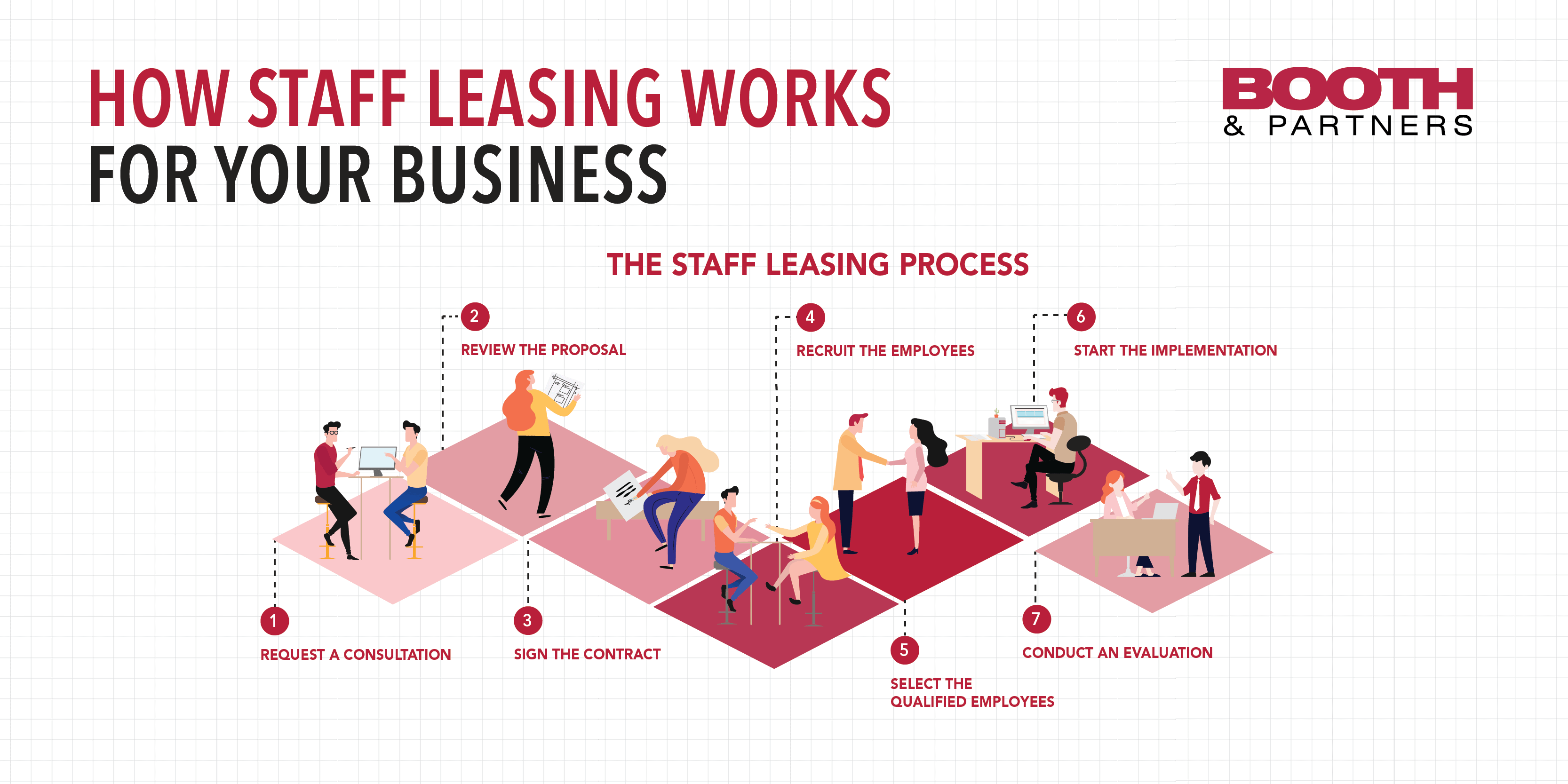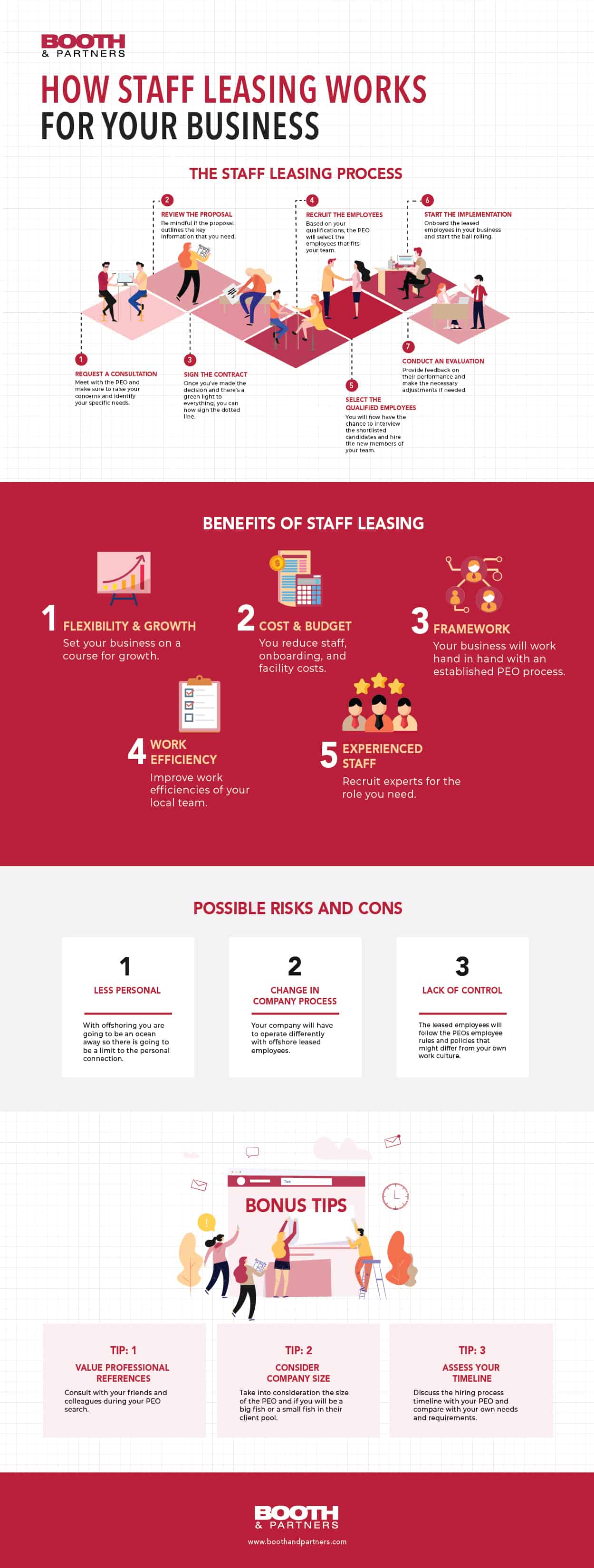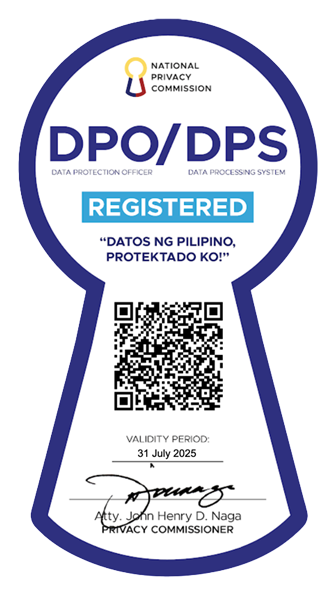How Staff Leasing Works for Your Business [Infographic]

Staff leasing is a business model that allows companies to outsource manpower through a Professional Employer Organization (PEO). The PEO can assist your business with its processes or job skills ranging from administrative and employee tasks, HR, accounting, to highly technical skills like Developers and Network Engineers.
The main difference between traditional outsourcing and staff leasing is the management reporting structure. For outsourced associates, they are managed by the internal management team of the outsourcing company. In a staff leasing solution, the client takes the primary responsibility to manage the offshore team through a placement of an identified team leader working alongside the associates. The client defines their own internal KPI’s and business policies in terms of managing their leased employees.
So how do you hit the ground running? Below are some of the benefits of staff leasing and the steps you can take to adapt it in your business.

The Staff Leasing Process
Here’s a step-by-step guide you can follow to ensure effective incorporation of staff leasing to your business.
1. Request a Consultation.
Meet with the PEO and make sure to raise your concerns and identify your specific needs. The PEO is there to assist you in this first stage of staff leasing.
Before anything else, check if staff leasing is really for your business. Determine the benefits of staff leasing to your business. Then, you can inquire about the positions and job descriptions of what you’re looking for.
2. Review the Proposal.
Read the proposal thoroughly. Be mindful if it outlines the key information that you need. The PEO should provide you with a comprehensive proposal where it will be easier for you to understand the scope and objective.
Don’t hesitate to ask questions if you find that there is vital information that you need.
3. Sign the Contract.
Once you’ve made the decision and there’s a green light to everything, you can now sign the dotted line. This is the start of your business opening up to the benefits of staff leasing.
4. Recruit the Employees.
The recruitment process in staff leasing is not a blind selection. These employees fit the job description and will perform well when given certain tasks in your business.
It’s a thorough process that assesses personal background and employee experience.
5. Select the Qualified Employees.
After completing a written test and an extensive interview process, the qualified candidates will be presented to you. You will now have the chance to interview the shortlisted candidates and hire the new members of your team.
6. Start the Implementation.
Once you’ve found the right employee (s), you will now have the employee’s starting date, onboarding process and training plan mapped out.
7. Conduct an Evaluation.
For staff leasing, it’s very crucial to evaluate the recruited employee (s). In this manner, the PEO will address your initial concerns and if necessary, a replacement of the said employee.
Even though meticulous steps have been taken during the recruitment & hiring process, it’s a different ball game altogether when you’re actually working with an employee. Adjustments may be needed.
Benefits of Staff Leasing
If you’re unsure whether staff leasing will work for your business, then here are some benefits:
1. Flexibility & Growth
Staff leasing gives you more breathing space in terms of dividing tasks and deciding on a budget. This will allow your business to grow in the right direction because you’ll have more sense of which tasks are prioritized and not.
2. Cost & Budget
Not only do you achieve flexibility and growth demands, you do so in a low-cost environment. Saving on direct and indirect staff costs such as payroll, HR, engagement, facilities, and benefits.
Keep in mind that just because you’re spending less does not mean that you’re getting subpar work. You will have highly specialized staff recruited specifically for their skillset as an integral part of your team.
3. Framework
One common concern for a startup or SME is the structure of their HR department. This department often gets overlooked in the early phase of a company’s lifecycle, yet it is one of the most important parts of a company.
With a PEO provider, you get access to their existing HR framework & process-driven management culture for a seamless HR process.
4. Work Efficiency
The tasks allocated to your offshore staff leased team will leave your local office (s) more streamlined and efficient. You can place more focus on the critical growth functions of your business. The back-office and high-volume tasks are now handled via your PEO provider.
5. Experienced Staff
Now that you have an established HR policy through a PEO, your business will attract top talent. Attracting talent is one step forward, the next step is retaining it. Numerous engagement activities will also be used by the PEO to retain your team of talented individuals on your behalf.
Possible Risks and Cons
1. Less personal
With offshoring, you are going to be working with your team remotely, so there is going to be a limit to the personal connection you will have with your team. However, the availability of collaborative platforms and internet communication systems are very ubiquitous in this day and age and that will help keep the personal connection alive while being miles apart.
2. Change in Company Process
The PEO employee policies and systems may differ from your own company’s direct hire policies, therefore there will be some adjustments in how your company operates with all of its employees.
Now, this isn’t entirely a bad thing if you’re a startup or an SME. It might even provide an improved structure that your budding business needs.
3. Lack of Control
The leased employees will follow the PEOs employee rules and policies and that might differ from your own work culture and structure.
Bonus Tips
1. Value Professional References
Before looking for the right PEO, make sure that you ask for advice and referrals from your colleagues and other professionals.
If they’ve used PEO services before, then they might have insights into how it works and what will be the best for your business.
2. Consider Company Size
Take into consideration the size of the PEO and if you will be a big fish or a small fish in their client pool. If you are a big fish to the PEO then you will likely get more personal attention versus if you were a small fish to the PEO.
3. Assess Your Timeline
Keep in mind that you should plan for a long runaway to recruit your team as it can take time to find the right team members for your business.
You should also check with your PEO provider on the available talent pool for the staff that you are looking to recruit especially for back-office outsourcing as the timeline to recruit depends on the job role and description you seek.
These are essential things to take note of when you’re thinking of having leased employees for your business. Staff leasing is a smart solution to the challenges faced by many startups and SMEs.
Discover more about outsourcing and
how you can maximize it for your
business success!
Get a copy of our E-book: Guide to Outsourcing.



